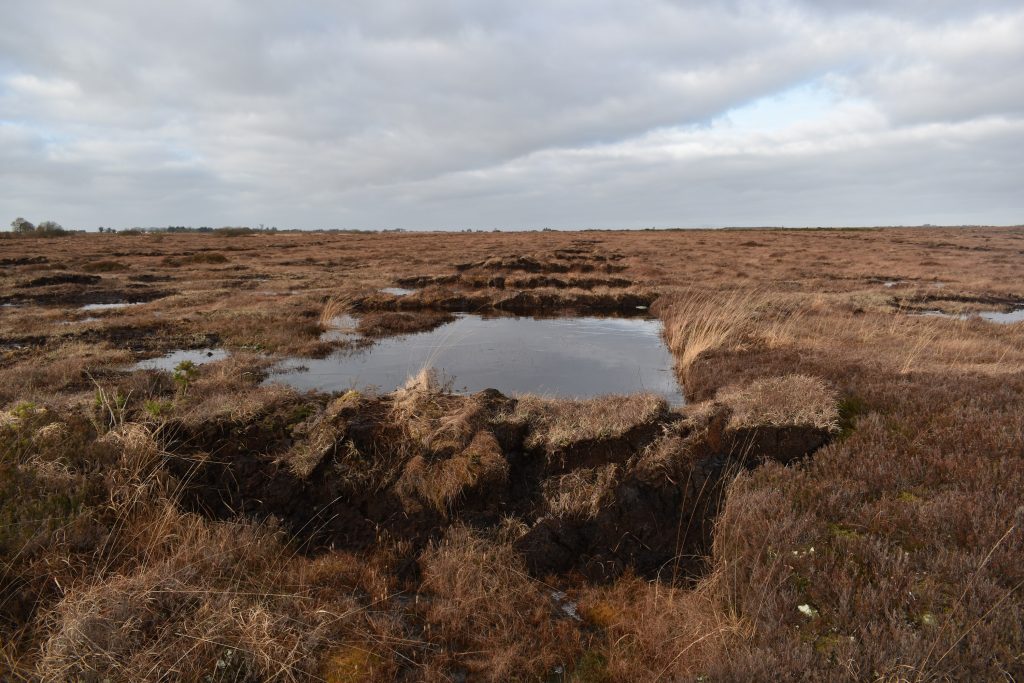Whilst on the road, in classrooms and communities, The Living Bog is often asked about the colour of water coming from, or near a bog, and if it’s safe to drink that water. The yellowish-brown colour of bog water is a familiar sight to anyone from the midlands (or indeed the uplands), and some of our rivers are sometimes coloured. What causes the colour? Dissolved Organic Matter, or DOM.
This blog explains what causes the colour and the associated impacts on water quality and hopefully answers some of the many questions out there about water from the bog, and stresses how important it is to keep that water on the bog…

Water discharged from the bogs contains Dissolved Organic Matter (DOM). DOM is principally composed of natural acids and proteins produced by the specialist peat forming plant species unique to bog ecosystems. It is the organic forms of carbon, nitrogen and phosphates contained in DOM that are responsible for the characteristic yellow brown colour of bog water.
These natural organic compounds are stable in the bog environments, which typically have low levels of dissolved oxygen. The Dissolved Organic Carbon (DOC), Dissolved Organic Nitrogen (DON), and Dissolved Organic Phosphorous (DOP) compounds are not immediately available as plant nutrients and hence DOM is not considered as a water pollutant in its own right.
Ecologically, DOM provides a substrate for bacteria and once in a receiving water course can also acts as a natural sunscreen, reducing the depth that UV light penetrates through the water column, protecting communities of decomposers (bacteria and protozoans) that provide a streams capacity to attenuate pollutants.
Bogs in their natural state are a carbon sink. Peat forming plants like sphagnum mosses remove carbon from that atmosphere. This carbon is stored in the bog as peat where water logging inhibits natural decay processes.
Draining the bog transforms the bog from a carbon sink to a carbon source.
Carbon is lost from the peat via two pathways, as direct atmospheric exchange through soil respiration and as DOM in discharge from the drainage ditches – or channels cut into the bog to dry it out for peat extraction. A drained bog will act as a carbon source until the bog is re-wetted (or no peat remains).
The carbon flux associated with DOM can exceed direct atmospheric exchange by orders of magnitude and accounts for the majority of the carbon flux from a ditched bog. Up to 90% of the carbon lost from degraded bogs is exported via drainage discharge.

Figure 1: Pathways of Carbon losses from degraded Peatlands
Once discharged into a receiving water course with comparatively high levels of dissolved oxygen DOM the organic carbon, nitrogen and phosphorous compounds that make up DOM are broken are broken down by decomposers. These processes result in the production of carbon dioxide, and inorganic forms of nitrates and phosphates. The carbon dioxide released in this way is considered a fugitive emission in current studies of bogs in relation to climate change and is a major cause of uncertainty in estimates of the climate change potential of degraded bogs.
The nitrates and phosphates that are released as by-products from the digestion of DOM by decomposers are considered as water pollutants by the EPA. This is not due to potential impacts on human or animal health, but because they contribute to a process known as Eutrophication, which has a negative impact on the ecology of the water course. Consequently, production bogs have been identified as a significant pressure on 8% of Irish rivers at risk of not meeting their environmental quality objectives under the Water Framework Directive.
There is evidence that ammonium (a natural by-product of decay processes) is present at elevated levels downstream of production bog sites. Ammonium is a recognised water pollutant as it is toxic to some fish species at low concentrations, there is no direct risk to human health posed by ammonium in drinking water.
Nitrates in water are implicated as a cause of methemolobinemia (blue-baby syndrome), which is caused by nitrogen combining with oxygen in the blood stream in preference to iron. Epidemiological evidence suggests that this represents a health hazard in babies less than 2 months of age where micro-nutrient deficiencies exist, and hence is not likely to be a significant risk in Ireland.
The other significant water pollutants from production sites are fine peat sediments.

A typical peat production site in the Irish midlands
These sediments are composed of Particulate Organic Carbon (POC) suspended in the discharge from the drains. POC is not known to cause a risk to human or animal health, but can have significant impacts on stream ecology. As POC’s settle out of suspension it can blanket stream beds, negatively impacting benthic species such as the fresh water pearl mussel.
The Living Bog project is sampling water quality from selected restoration sites on a monthly basis. For example the concentration of Nitrate at the discharge point on Killyconny Bog, Co Cavan on 23/09/2019 was less than 1.67 mg/L, which is an order of magnitude lower than existing Maximum Allowable Concentration (MAC) of 50 mg/L set by the Drinking Water Directive. This concentration would be reduced significantly by dilution on entering the receiving water course.
DOC had a concentration of 45.1 mg/L and TOC 46.7 mg/L. Particulate Organic Matter (POC) present in a concentration of 1.6 mg/L. There are no published MAC’s for these parameters, so the project will seek to compare the concentrations from restored sites with the data the EPA has available on production sites over the course of the next 12 months, in order to determine how drain blocking impacts on water quality ecosystem services.
Tri-halo methanes (THM’s) are formed by a reaction between chlorine and organic compounds (principally DOM). THM’s are thought to be carcinogens as there is epidemiological evidence that prolonged exposure to THM’s leads to elevated rates of some stomach cancers. As DOM is dissolved in the bog water it cannot be removed from water via filtration or coagulation /flocculation, which are the traditional primary stages in water treatment. Hence treating water with high levels of DOM is expensive. Consequently water sources that have high levels of DOM or are highly coloured have been avoided by water supply utilities to avoid the costs of associated with treatment.
Traditionally water entering a pipeline from a water treatment plant is dosed with chlorine. This acts as a disinfectant and is an effective treatment of the main pathogens that cause serious diarrhoeal diseases such as dysentery. It is considered an essential part of the treatment process as the chlorine dose provides a residual disinfection effect as water passes through the transmission pipeline, ensuring potable quality at the consumers tap.
THM’s are not formed naturally in concentrations that would impact human health under natural conditions. They are part of a wider group of compounds collectively known as Chlorine by-products (CBP’s). There are maximum acceptable concentration limits set by the EC Drinking Water Directive for THM’s and CBP’s, and compliance monitoring is undertaken routinely by the EPA. Hence the occurrence of DOM in a peatland catchment is only likely representing a risk to human health if there is a water abstraction point downstream of the bog. This is unlikely as water utilities would not abstract surface water from a source with high DOM concentrations, it would be cheaper to pump it from a borehole. Drinking bog water without treatment will would likely cause acute diarrheal disease.

Drainage ditches on Carrownagappul Bog SAC, blocked by The Living Bog with peat dams in autumn 2019
From the above it can be concluded that restoring the bogs will have the following net benefits to the ecological status of the receiving water courses:
- Reduce the amount of sediments entering the receiving water course;
- Reduce the amount of ammonium being directly discharged into the water course.
- The impacts in relation to DOC are less clear. From first principles increasing the residence time of water on the bog surface will increase DOM concentrations, as will increased coverage of Sphagnum, as the amino acids produced by the sphagnum is a contributing factor to low pH on bogs. However there are no negative health impacts associated with the DOC and it is not considered a pollutant, and increased concentrations could well be considered an important ecosystem service function of bog restoration. The production of ammonium resulting in microbial breakdown of DOM is unlikely to cause toxicity as this process will be naturally regulated. The project will monitor the impacts of drain blocking on DOC concentrations using FDOM sensors installed in hydraulic measuring structures.
Blocking drains on the bogs will have a net positive impact on water quality. As the ecological status of the bog improves, so too will the ecological status of the receiving water course. No negative impacts on human health can be anticipates associated with water quality as water supply companies are required to control THM concentrations as part of their treatment processes.

Sunset on Ardagullion Bog SAC, Co Longford, December 2019, one year after restoration works. Pic: John Cody, Hydrologist, The Living Bog.
LINKS TO NOTE:
EPA Catchment Unit, Significant pressures (peat) – https://www.catchments.ie/significant-pressures-peat/
Local Authorities Water Programme http://watersandcommunities.ie/
KerryLIFE Project: http://www.kerrylife.ie/ (Sustainable land use management for the conservation of the freshwater pearl mussel)
PAPERS
‘An overview of dissolved organic carbon in groundwater and implications for drinking water safety’ by Dr Shane Regan, Paul Hynds & Ray Flynn.
https://www.researchgate.net/publication/316351764_An_overview_of_dissolved_organic_carbon_in_groundwater_and_implications_for_drinking_water_safety





